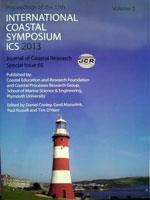Soomere, T., 2013. Extending the observed Baltic Sea wave climate back to the 1940s.
Systematic visual wave observations have been performed since 1946 at numerous locations on the eastern coast of the Baltic Sea. The records of wave height that mostly exist since 1954 are reconstructed back to 1946 using the high correlation (about 0.85) between the wave height and qualitative measures of sea state, and a linear regression between these quantities at Ventspils and Liepaja (Kurzeme Peninsula, Latvia). The analysis confirms the well-known properties of the Baltic Sea wave fields such as a relatively low overall wave intensity, short wave periods at the nearshore, high spatio-temporal variations in the average wave height and a strong evidence of decadal-scale changes. A part of the relevant changes are in counterphase for the southern and the northern Baltic Sea. There has been a relatively rapid decrease in the average wave height in the eastern Baltic Sea from the end of 1940s until ~1970, and a slow increase since then. No secular trend in the wave intensity is evident at any observation site from the Curonian Peninsula up to the northern Baltic Proper. The results suggest that much longer wave hindcasts (at least 50–60 years) driven by realistic wind patterns are necessary to properly quantify the changes to the wave fields in this basin.





